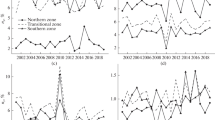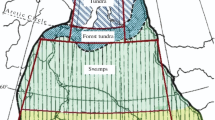Abstract
Summer statistical models of textural features and physical parameters for various cloud types over the northern and southern parts of Western Siberia are proposed. The MODIS satellite data obtained over the study region in June, July, and August from 2010 to 2019 are considered. The model was constructed by determining the distribution laws that describe fluctuations in the values of various cloud parameters based on the Kolmogorov–Smirnov test. The summer cloud classification, that includes 14 cloud types, is presented. A feature of constructing a statistical model of optical thickness for powerful towering vertical clouds is considered. Estimates of the mean and relative standard deviation are given for some parameters and all considered cloud types in the northern and southern parts of Western Siberia. The results of forming statistical models both for individual cloud levels and for all varieties in general are discussed. Promising areas of develo** the present study are given.


Similar content being viewed by others
REFERENCES
V. G. Astafurov, T. V. Evsyutkin, K. V. Kur’yanovich, and A. V. Skorokhodov, “Classification of the Main Cloud Type Textures from MODIS Data Using Fuzzy Systems,” Sovremennye Problemy Distantsionnogo Zondirovaniya Zemli iz Kosmosa, No. 5, 14 (2017) [in Russian].
V. G. Astafurov, K. V. Kur’yanovich, and A. V. Skorokhodov, “A Statistical Model for Describing the Texture of Cloud Cover Images from Satellite Data,” Meteorol. Gidrol., No. 4 (2017) [Russ. Meteorol. Hydrol., No. 4, 42 (2017)].
V. G. Astafurov and A. V. Skorokhodov, “Segmentation of Cloud Satellite Images by Textural Features Based on Neural Network Technologies,” Issledovanie Zemli iz Kosmosa, No. 6 (2011) [in Russian].
V. G. Astafurov and A. V. Skorokhodov, “Statistical Model of Physical Parameters of Clouds Based on MODIS Thematic Products,” Issledovanie Zemli iz Kosmosa, No. 5 (2017) [in Russian].
B. A. Ashabokov, L. M. Fedchenko, V. O. Tapaskhanov, A. V. Shapovalov, V. A. Shapovalova, M. K. Makuashev, A. Kh. Kagermazov, L. T. Sozaeva, A. A. Tashilova, and L. A. Kesheva, Physics of Hail Clouds and Their Modification: Current State and Development Trends (Pechatnyi Dvor, Nalchik, 2013) [in Russian].
D. P. Bespalov, A. M. Devyatkin, Yu. A. Dovgalyuk, V. I. Kondratyuk, Yu. V. Kuleshov, T. P. Svetlova, S. S. Suvorov, and V. I. Timofeev, The Atlas of Clouds (D’ART, St. Petersburg, 2011) [in Russian].
R. N. Vadzinskii, Reference Book on Probability Distributions (Nauka, St. Petersburg, 2001) [in Russian].
E. V. Volkova, “Estimation of Cloud Cover and Precipitation Parameters Using Data from MSU-MR Radiometer of Meteor-M No. 2 Polar-orbiting Satellite for the European Part of Russia,” Sovremennye Problemy Distantsionnogo Zondirovaniya Zemli iz Kosmosa, No. 5, 14 (2017) [in Russian].
A. V. Kislov, Climatology and Fundamentals of Meteorology (Akademiya, Moscow, 2016) [in Russian].
Climate of Russia, Ed. by N. V. Kobysheva (Gidrometeoizdat, St. Petersburg, 2001) [in Russian].
KN-01 SYNOP. The Code for Operational Transfer of Data of Surface Meteorological Observations from the Roshydromet Station Network (Gidrometeoizdat, St. Petersburg, 2012) [in Russian].
A. I. Kobzar’, Applied Mathematical Statistics: For Engineers and Scientists (Fizmatlit, Moscow, 2006) [in Russian].
N. V. Kolodnikova, “A Review of Textural Features for the Problems of Pattern Recognition,” Doklady Tomskogo Gosudarstvennogo Universiteta Sistem Upravleniya i Radioelektroniki, No. 1, 9 (2004) [in Russian].
V. S. Komarov, S. N. Il’in, A. V. Lavrinenko, N. Ya. Lomakina, E. V. Gorev, and D. P. Nakhtigalova, “Climate Conditions of Low-level Clouds over the Territory of Siberia and Its Modern Change. Part 1. Features of Low-level Cloud Conditions,” Optika Atmosfery i Okeana, No. 7, 26 (2013) [in Russian].
V. S. Komarov, G. G. Matvienko, S. N. Il’in, and N. Ya. Lomakina, “Estimate of Local Features of Long-term Variations in Cloud Cover over the Territory of Siberia Using Results of Its Climatic Zoning According to Total and Low-level Cloud Regimes,” Optika Atmosfery i Okeana, No. 1, 28 (2015) [Atmos. Ocean. Opt., 28 (2015)].
V. S. Komarov, D. P. Nakhtigalova, S. N. Il’in, A. V. Lavrinenko, and N. Ya. Lomakina, “Climatic Zoning of Siberia According to the Total and Low-level Cloudiness Regime as a Basis for Construction of Local Cloud Atmosphere Models. Part 1. Methodical Bases,” Optika Atmosfery i Okeana, No. 10, 27 (2014) [in Russian].
V. V. Kruglov, M. I. Dli, and R. Yu. Golunov, Fuzzy Logics and Artificial Neural Networks (Fizmatlit, Moscow, 2001) [in Russian].
Yu. L. Matveev, L. T. Matveev, and S. A. Soldatenko, Global Field of Cloudiness (Gidrometeoizdat, Leningrad, 1986) [in Russian].
V. K. Morgunov, Fundamentals of Meteorology and Climatology. Meteorological Instruments and Observation Techniques (Feniks, Rostov-on-Don, 2005) [in Russian].
Clouds and Cloudy Atmosphere. Reference Book, Ed. by I. P. Mazin and A. Kh. Khrgian (Gidrometeoizdat, Leningrad, 1989) [in Russian].
A. V. Skorokhodov, V. G. Astafurov, and T. V. Evsyutkin, “Using Statistical Models of Image Texture and Physical Parameters of Clouds for Their Classification Based on MODIS Satellite Data,” Issledovanie Zemli iz Kosmosa, No. 4 (2018) [in Russian].
E. V. Kharyutkina, S. V. Loginov, E. I. Usova, Yu. V. Martynova, and K. N. Pustovalov, “Trends in Climate Extremity in Western Siberia at the End of the 20th Century and the Beginning of the 21st Century,” Fundamental’naya i Prikladnaya Klimatologiya, No. 2 (2019) [in Russian].
A. V. Chernokul’skii and I. I. Mokhov, “Comparative Analysis of Global and Zonal Cloud Characteristics Based on Various Satellite and Ground-based Observations,” Issledovanie Zemli iz Kosmosa, No. 3 (2010) [in Russian].
N. P. Shakina, Lectures on Dynamic Meteorology (TRIADA, Moscow, 2013) [in Russian].
S. M. Shmeter, Physics of Convective Clouds (Gidrometeoizdat, Leningrad, 1972) [in Russian].
S. A. Ackerman, R. Frey, A. Heidinger, Y. Li, A. Walther, S. Platnick, K. G. Meyer, G. Wind, N. Amarasinghe, C. Wang, B. Marchant, R. Holz, S. Dutcher, and P. Hubanks, EOS MODIS and SNPP VIIRS Cloud Properties: User Guide for the Climate Data Record Continuity Level-2 Cloud Top and Optical Properties Product (CLDPROP) (NASA, Greenbelt, MD, USA, 2019).
C. Arbizu-Barrena, D. Pozo-Vazquez, J. A. Ruiz-Arias, and J. Tovar-Pescador, “Macroscopic Cloud Properties in the WRF NWP Model: An Assessment Using Sky Camera and Ceilometer Data,” J. Geophys. Res. Atmos., 120 (2015).
R. L. Bankert, C. Mitrescu, S. W. Miller, and R. H. Wade, “Comparison of GOES Cloud Classification Algorithms Employing Explicit and Implicit Physics,” J. Appl. Meteorol. Climatol., 48 (2009).
T. Chen, W. B. Rossow, and Y. Zhang, “Radiative Effects of Cloud-type Variations,” J. Climate, 13 (1999).
A. Chernokulsky and I. Esau, “Cloud Cover and Cloud Types in the Eurasian Arctic in 1936–2012,” Int. J. Climatol., 39 (2019).
A. V. Chernokulsky, I. I. Mokhov, and N. G. Nikitina, “Winter Cloudiness Variability over Northern Eurasia Related to the Siberian High during 1966–2010,” Environ. Res. Lett., No. 4, 8 (2013).
D. K. Danso, S. Anquetin, A. Diedhiou, C. Lavaysse, A. Kobea, and N. E. Toure, “Spatio-temporal Variability of Cloud Cover Types in West Africa with Satellite-based and Reanalysis Data,” Quart. J. Roy. Meteorol. Soc., 145 (2019).
R. Eastman and S. G. Warren, “Diurnal Cycles of Cumulus, Cumulonimbus, Stratus, Stratocumulus, and Fog from Surface Observations over Land and Ocean,” J. Climate, 27 (2014).
D. P. Grossvenor and R. Wood, “The Effect of Solar Zenith Angle on MODIS Cloud Optical and Microphysical Retrievals within Marine Liquid Water Clouds,” Atmos. Chem. Phys., 14 (2014).
I. Gultepe, G. A. Isaac, and K. Strawbridge, “Variability of Cloud Microphysical and Optical Parameters Obtained from Aircraft and Satellite Remote Sensing during RACE,” Int. J. Climatol., 21 (2001).
36. C J. Hahn, S. G. Warren, and R. Eastman, Extended Edited Synoptic Cloud Reports from Ships and Land Stations over the Globe, 1952–2009 (NDP-026C) (2012).
R. M. Haralick, K. Shanmugam, and I. Dinstein, “Textural Features for Image Classification,” IEEE Trans. Systems, Man and Cybernetics, No. 6, 3 (1973).
M. D. King, S. Platnick, W. P. Menzel, S. A. Ackerman, and P. A. Hubanks, “Spatial and Temporal Distribution of Clouds Observed by MODIS Onboard the Terra and Aqua Satellites,” IEEE Trans. Geosci. Remote Sens., 51 (2013).
Y. Liu, J. **a, C.-X. Shi, and Y. Yang, “An Improved Cloud Classification Algorithm for China’s FY-2C Multi-channel Images Using Artificial Neural Network,” Sensors, 9 (2009).
MODIS Atmosphere. Cloud (06_L2), https://modis-atmos.gsfc.nasa.gov/products/cloud.
J. A. Otkin and T. J. Greenwald, “Comparison of WRF Model-simulated and MODIS-derived Cloud Data,” Mon. Wea. Rev., 136 (2008).
D. Painemal, R. Garreaud, J. Rutllant, and P. Zuidema, “Southeast Pacific Stratocumulus: High-frequency Variability and Mesoscale Structures over San Felix Island,” J. Appl. Meteorol. Climatol., 49 (2010).
G. Thompson, M. Tewari, K. Ikeda, S. Tessendorf, C. Weeks, J. Otkin, and F. Kong, “Explicitly-coupled Cloud Physics and Radiation Parameterizations and Subsequent Evaluation in WRF High-resolution Convective Forecasts,” Atmos. Res., 168 (2016).
M. Unser, “Sum and Difference Histograms for Texture Classification,” IEEE Trans. Pattern Anal. Mach. Intell., No. 1, 8 (1986).
J. S. Weszka, C. R. Dyer, and A. Rosenfeld, “A Comparative Study of Texture Measures for Terrain Classification,” IEEE Trans. Systems, Man, and Cybernetics, No. 4, 6 (1976).
R. Wood, “Stratocumulus Clouds,” Mon. Wea. Rev., 140 (2012).
A. H. Young, K. R. Knapp, A. Inamdar, W. Hankins, and W. B. Rossow, “The International Satellite Cloud Climatology Project H-Series Climate Data Record Product,” Earth Syst. Sci. Data, 10 (2018).
Author information
Authors and Affiliations
Corresponding author
Additional information
Translated from Meteorologiya i Gidrologiya, 2021, No. 11, pp. 20-35. https://doi.org/10.52002/0130-2906-2021-11-20-35.
About this article
Cite this article
Astafurov, V.G., Skorokhodov, A.V. & Kur’yanovich, K.V. Summer Statistical Models of Cloud Parameters over Western Siberia According to MODIS Data. Russ. Meteorol. Hydrol. 46, 735–746 (2021). https://doi.org/10.3103/S1068373921110029
Received:
Revised:
Accepted:
Published:
Issue Date:
DOI: https://doi.org/10.3103/S1068373921110029




